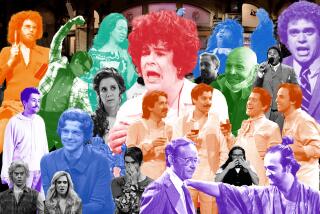The road to ‘On the Road’
- Share via
IN 1950, a young writer from Lowell, Mass., published what he hoped would be an important American novel, a book that evoked the country at a critical cultural shift. His name, John Kerouac, the book, “The Town and the City.”
Despite largely polite, even generous reviews, Kerouac was weighed down by doubts. It wasn’t the story, it was the telling -- which to his ear, lacked urgency.
By then, he was already bent frantically toward something else, two manuscripts that were shape-shifting works-in-tandem: “Visions of Neal” (after his friend, muse and fellow itinerant spirit, Neal Cassady) and another, a draft of which had been famously pounded out on teletype paper during a Benzedrine high, “On the Road.”
Not quite stalled but idling, Kerouac was searching for something that would take him beyond a conventional, linear road-trip narrative, that would evoke the sense of dislocation he felt in himself and others, an uneasy mix of restlessness and desperation. He was casting about for a way to convey not just motion but emotion, visions, spiritual revelations -- as fast as they came to him in breathless flashes on the highway.
What happened after “On the Road” found traction in 1957 is an indelible chapter of American history. Less known, however, is the specific step-by-step process of Kerouac’s arrival as a literary icon: the seven years it took to get from “John” to “Jack,” to become the unwitting father of the Beat Generation, to get to that mad rush of prose.
The newly released “Book of Sketches” is the embodiment of Kerouac’s painstaking progression toward this “new style of writing,” his propulsive literary breakthrough. Written, for the most part, between 1952 and 1954, it is in many ways the road to “On the Road.”
Sketching came to Kerouac by way of a Denver friend, Ed White, who suggested that he work like a painter “but with words.” Kerouac took to the idea immediately, filling nickel notebooks that he kept in his breast pocket. He improvised, working like a jazz musician, following his emotions, writing until he was bored or spent. When he sketched, he later told his friend, poet Allen Ginsberg, he felt he wrote with 100% honesty; he had finally found a voice at last.
These notebooks convey a multilayered journey, including not just his descriptions of life in Rocky Mount, N.C., and in a San Francisco tenement, but also his digressions, epiphanies and “Tics,” which he defined as flashes of memory or daydreams, “a sudden thought that inflames & immediately disappears.”
In an introduction that itself reads like an associative riff, painter and sculptor George Condo compares Kerouac to his iconoclastic contemporary Jackson Pollock, who also had the ability to turn the everyday “into Art.” Condo labels Kerouac a Cubist, “in the sense that the fragmentation is not of imagery but of time and place.” His stream-of-consciousness seems “to be running straight at you and then split[s] up unexpectedly into multiple directions simultaneously, ending on a resolved note somehow related and yet striking out in a new direction.”
Oddly, Condo doesn’t address either the timing or the key role these sketches played in Kerouac’s formulation as a writer. It’s a striking omission. By 1952, Kerouac was marooned between drafts of “On the Road,” desperately looking for a way of working that would allow him to get underneath the skin of things. Hitting on the flow of “spontaneous prose,” Kerouac finally set to reworking the manuscript, applying what he’d learned by sketching. It was his turning point; he’d unearthed his writing soul.
The term “sketches” seems just right, a precise way to describe these otherwise uncategorizable vignettes: a flow of fragments -- some jagged, some iridescent, some goofing or drifting -- that vary in theme or length or tone. They aren’t quite poetry, aren’t quite narrative prose, yet some feel too finished to be cast off as simply jottings. They are epiphanies with shape and form and shadings; they are maps of the mind.
Like so much else in his life -- bebop before, Buddhism later -- Kerouac took to sketching like a religious rite, recording everything as fast as his fingers could move. This includes the rhythms of his sister Caroline’s home (“She / prepares the aluminum / silex for coffee -- never / puts an extra scoop for / the pot -- makes weak / American housewife coffee”), the old folks sitting stoically on front porches and the fraternity of a crowded city bar:
young, welldressed,
justsuits, puffing
cigars, glad to
have the day done
& the drink comin
in, side by side
march in smiling
but there’s no
room at the roaring
... crowded
bar so they stand
2 deep from it
waiting & smiling
& talking --
Men do love bars &
Good bars shd. be
loved --
Kerouac took many of his cues from jazz, particularly when it came to his spontaneous prose, but these sketches underscore that just as important as the sound of language was the pace at which essential details shimmer up from the page. It’s like watching key elements in a photograph develop, the old-fashioned way, in a tray.
Taking in the details -- a barber coat over a chair, boys walking “handsapockets” along boxcar tops -- one can see why Kerouac and photographer Robert Frank, his occasional collaborator, so naturally meshed. There is a colloquial directness, a rough lyricism their work shares. At first, these sketches feel like moody still lives: “-- in window burlesk / ad, whitewashed flowerpot / of tub with soil & crazy / redblossomed weeds.” But as they pull back, unwind and wander, they find power in a contained momentum: how each detail holds his gaze. In their hurly-burly pacing, they feel like home movies, like something raw, in-the-moment, what we used to call art films.
“Book of Sketches” is a vitrine of midcentury curios that represent an America vanishing. The visual details of Kerouac’s travels, the sweeping back and forth across the country, are simply the overlay. These compressed musings also diagram a man’s turbulent psyche and his often painful attempts to find a voice, to box with hydra-headed demons (insecurity, paranoia, alcohol), even as he tries to lay claim to his elusive place in the world. They are worry beads on paper: “I will be saved, i.e., / I am not a dead duck, / not a criminal, a / bum, an idiot, a fool / -- but a great poet / & a good man -- & / now that that’s settled I / will stop worrying about / my position.”
What Kerouac carried back in these notebooks are souvenirs of an inner journey. Coming to a dead end, even in his despair or bitterness, he was determined to find promise and joy, luminous moments packed into a dime-store notebook, moments that reflect what was pulsing and alive, what he felt was left of the goodness in America -- its hope.
Kerouac, who died in 1969 at age 47, spent much of his short life rushing to get at life’s essence, boring through experience, borders, speed limits, states-of-consciousness: any barrier he could think of to get at It -- a tough brilliance. He was always pressing for clarity, a new way of seeing, whether through drugs or drink or geographical solution.
Perhaps most important, he found a way to give language movement -- that and a sense of an eyes-wide-open sweep. His breathlessness of voice, the everything-at-once vision that made “On the Road” fresh and subversive is braided throughout “Book of Sketches.” Such a tone, at turns euphoric and melancholy, would color the many stories that would follow. The dozen books that would ultimately make up the legend of his life were a way for Kerouac to write not just himself into being, but also the world as he knew it:
Let them pick the story
out of the house of your
words, floor by floor, room
by room. *
More to Read
Sign up for our Book Club newsletter
Get the latest news, events and more from the Los Angeles Times Book Club, and help us get L.A. reading and talking.
You may occasionally receive promotional content from the Los Angeles Times.










